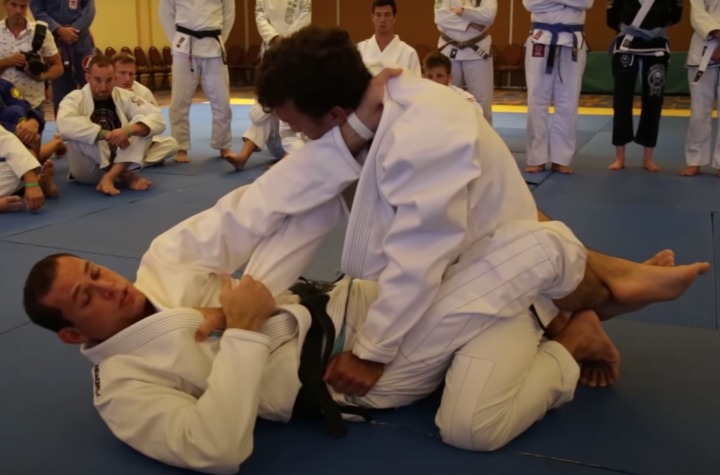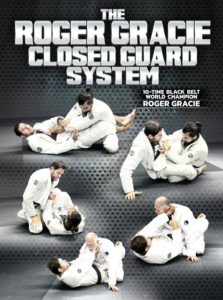The full guard, also known as the closed guard, is one of BJJ’s strongest positions. Full guard is basically an upside-down mount position for the person on the bottom. In full guard, the individual in the bottom position wraps his or her legs around the person on top. From full guard, the bottom player can defend strikes, apply submissions, and initiate sweeps. The full guard is a great BJJ, MMA, and self-defense position. In this article, we provide tips on developing a strong full guard and discuss a few basic techniques from this position.
Full Guard Tips
Tip #1: Use Your Hands and Legs
When playing full guard, you must be active with your hands and legs. While your opponent is in your full guard, you should usually use one hand to control your opponent’s sleeve and another to control your opponent’s collar. Of course, there are other hand positions you may use, but the key takeaway here is that you should always be gripping something. However, only using your hands isn’t enough. You also must use your legs to pull your opponent into you. By using your hands and legs in tandem, you can control your opponent’s posture.
Tip #2: Use Your Hips
Another important component of an effective full guard is active hips. When your hips are stationary, you tend to lie flat on your back. This limits your mobility and makes your full guard far less effective. By keeping your hips active, you can keep your opponent off balance and begin to initiate sweeps and submissions. For example, the hip bump sweep, which we discuss below, relies heavily on hip movement.
Common Techniques from the Full Guard
The Hip Bump Sweep
The hip bump sweep is a simple but powerful full guard sweep that all BJJ students should know. The hip bump sweep involves trapping your opponent’s arm and using explosive hip movement to place him or her on the ground. The hip bump sweep is performed as follows:
- From the full guard, pull your knees close to your body. This will force your opponent to place his or her hands on the mat in an attempt to maintain posture.
- When your opponent’s hands hit the mat, open your full guard and post one of your hands on the mat.
- Using your posted hand to push off the mat, raise your hips towards your opponent in the direction of your posted arm.
- As you raise your hips towards your opponent, rotate your body in the direction of your posted arm, and use your opposite arm to cup your opponent’s elbow. This will trap your opponent’s arm, preventing him or her from posting it to prevent the sweep.
- Explosively thrust your hips in the direction of your posted arm and your opponent’s trapped arm.
- Upon completion of the hip bump sweep, you will land on top of your opponent in the full mount position.
The Armbar
The armbar is one of BJJ’s most effective submissions. Although the armbar can be applied from multiple positions, most BJJ students initially learn to apply it from full guard. The armbar is effective because it creates an anatomical mismatch that pits the attacking student’s entire body against his or her opponent’s elbow joint. When performed to completion, the armbar hyperextends the elbow joint, forcing the opponent to submit. The full guard armbar is performed as follows:
- When attacking your opponent’s right arm, grip his or her right arm above the elbow with your right hand.
- Place your left hand on your opponent’s left shoulder and pull your opponent down slightly.
- Place your left foot on your opponent’s right hip, and press your left leg against his or her body. This movement, along with your grip, will ensure that your opponent’s right arm remains trapped.
- Push against your opponent’s right hip with your left foot, rotating your body to the left.
- As you rotate your body, create pressure on your opponent’s back with your right leg, breaking his or her posture.
- Swing your left leg under your opponent’s neck, pressing his or her head towards the ground.
- With your opponent’s arm still pinned to your chest, raise your hips. As you perform this movement, keep your knees squeezed together. This will complete the submission.
The Triangle Choke
The triangle choke is one of the most powerful submissions in BJJ. Although there are multiple ways to finish this submission, the triangle choke is usually applied from the full guard. The full guard triangle is performed as follows:
- From the full guard, establish grips on both of your opponent’s wrists. Grabbing your opponent’s wrists prevents him or her from securing grips, passing your guard, and striking. In addition, controlling your opponent’s wrists allows you to position your opponent’s arms for the choke.
- Push one of your opponent’s arms against his or her torso while bringing the other arm forward. This puts your opponent in the one arm in/one arm out position, which is necessary to apply the triangle choke.
- After you’ve placed your opponent in the one arm in/one arm out position, open your full guard momentarily and explode your hips upward.
- Pull forward with your legs and use both of your hands to pull down on your opponent’s head.
- Push off of your opponent’s opposite hip with your foot to shift your body into a position that is perpendicular to your opponent’s body. You must unlock your legs to perform this movement, so it is necessary to grasp your shin behind your opponent’s neck and pull down to maintain control of your opponent’s posture. After completing this movement, one side of your opponent’s face should be directly in your line of sight.
- If you opened your legs to achieve a proper angle, you must relock them. In order to do this, place the top side of the ankle of the leg that is behind your opponent’s neck under the knee of your opposite leg. After relocking your legs, ensure that your opponent’s trapped arm is positioned across his or her body. With your opponent’s arm in position and your legs locked, squeeze your legs together and pull down on your opponent’s head.
Conclusion
The full guard position is one of BJJ’s greatest weapons. Therefore, every BJJ student should develop a strong full guard. If you devote time to practicing techniques from the full guard, your overall BJJ game will improve exponentially.
Learn from the most successful closed guard player ever with Roger Gracie’s closed guard system, totally explained in this 4-part series
- Lock on airtight submissions that work at elite levels, including cross chokes, lapel chokes, arm locks, and more.
- Roger Gracie is one of the most dominant grapplers in history, with 10 Black Belt World Championships and 2-Time ADCC Champion – and he did it with old school Brazilian Jiu-Jitsu.


















